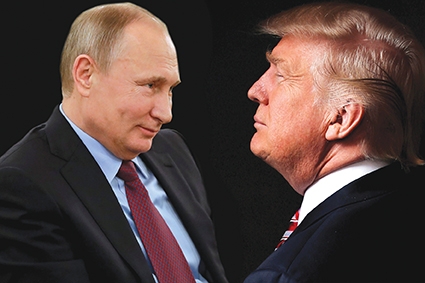Trump Meets Putin but Not Russian Hopes
In politics, large gatherings of leaders, summits, etc. rarely yield immediate results. Throughout history there were numerous famous gatherings such as the Congress of Vienna (1814-1815), Congress of Berlin (1878) or Versailles Conference (1919) following the end of the World War I. If significant results ensued these events, they were either decided beforehand by lower level diplomats or during the conferences, with only a tiny group of leaders forging out the important clauses and other details.
Last week, the world witnessed the G20 event in Hamburg and many thoughts were propounded as to what impact it would have on climate, economics or crises across the globe from Syria to North Korea. However, here, again, the gathering of the world leaders did not produce any tangible results. As a token of fatigue was the much greater interest the world had in the planned meeting between the Russian and US presidents rather than the summit declaration or speeches on military or economic problems of the world.
Indeed, the Putin-Trump meeting was a highlight, with politicians, pundits and even psychologists studying every gesture and move of the leaders. The two spoke for more than the expected 30-40 minutes and after the two-hour, 15-minute discussion some details were revealed. Putin and Trump agreed on establishing a ceasefire in south-west Syria, hailed as a start of the cooperation between Moscow and Washington. Although details about the agreement and how it will be implemented weren't immediately available, the cease-fire was set to take effect July 9 at noon Damascus time.
Putin himself later, at the beginning of his meeting with Shinzo Abe, the Japanese Prime Minister, noted that he and Trump discussed Syria, Ukraine, counterterrorism and even measures to counter world cyber-crime. Moreover, Russian FM Lavrov and US Secretary of State Tillerson said that the presidents also touched upon the very sensitive issue of alleged Russian interference in the US presidential elections in 2016.
But how far could this seeming cooperation between the two countries go? The start for that is a ceasefire in Syria, but we have witnessed numerous times over the past years how shaky announced ceasefires in Syria have been. Could the détente spill over into Eastern Europe and the South Caucasus?
In fact, to decode the real atmosphere we need to look not at the statements and handshakes or even the Syria decision during the summit, but what happened before and after the summit. As I wrote several days ago, any real cooperation between Moscow and Washington would be hampered by those geopolitical constrains which drive the two countries in Eurasia. Those interests are at odds in Ukraine, Eastern Europe, South Caucasus and Syria. Even if some serious steps are taken towards conflict resolution, this will only be possible if one of the two actors sacrifices its core interests. Thus, this makes it very unlikely that the Trump-Putin meeting (with the ceasefire agreed in south-western Syria) will translate into something more than a good attempt.
In fact, what happened before and after the summit was more revealing about the US stance towards Russia. For instance, just before Trump joined the G20 Summit in Hamburg on July 7, he visited Poland where in an address in Warsaw he urged Russia “to cease its destabilizing activities in Ukraine and elsewhere”. He also reaffirmed Washington's commitment to NATO's Article 5.
In addition, a day later the Polish government announced that the US was ready to sell another eight sets of Patriot systems. This will be added to what Poland already purchased from Washington from 2010 for the defense of its border with the Russian Kaliningrad and against Iskander systems.
Yet another powerful gesture by Washington was made following the summit when on July 9, Tillerson visited Ukraine and delivered a harsh statement on Russia that it is the Kremlin that must take the first step to ease tensions in Ukraine. Tillerson even added that the war in Ukraine was "planned and launched from Moscow." Later on, Trump tweeted that no moves on sanctions would be made unless Moscow exerts positive influence on breakaway entities in eastern Ukraine and Syria.
This again attests, as previously written, to the fact that despite rhetoric, Russian and US interests are in fact nearly incompatible in the former Soviet Union space and elsewhere. For Russia, the growing US military posture in Eastern Europe is unacceptable from the security side which will make Moscow pursue militarization of its western parts of the country. While each side will try to find a common ground and negotiations and meetings will take place, a protracted US-Russia confrontation is likely to continue.
Emil Avdaliani












